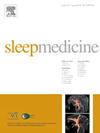Loudness of snoring, not apnea-hypopnea index, is associated with hyperactivity behavior in snoring children and adolescents
IF 3.8
2区 医学
Q1 CLINICAL NEUROLOGY
引用次数: 0
Abstract
Study objectives
It is unknown whether loudness of snoring or hypoxic burden are related to higher hyperactivity scores in habitually snoring children and whether this effect is impacted by the severity of sleep-disordered breathing (SDB). This study investigates the prevalence of hyperactivity in children with habitual snoring and the independent effects of loudness of snoring, as reported by the parents, hypoxic burden and obstructive sleep apnea syndrome's severity (OSAS) on hyperactivity, as measured by the Conners' Parent Rating Scale-Hyperactivity Index (CPRS-HI).
Methods
Children with habitual snoring aged 3–18 years were recruited for an overnight polysomnography reporting apnea-hypopnea index (AHI) and hypoxic burden, acoustic rhinometry, clinical examination and parental questionnaires assessing snoring loudness and CPRS-HI.
Results
The study analysis included 512 children (median (25th; 75th percentile) age, 10.6 (7.6; 13.4) years; 295 (58 %) males), of whom 358 (70 %) were overweight or obese and 179 (35 %) had an obstructive AHI >3/h. Findings revealed that 36 % [95 % CI: 32%–41 %] of children exhibited increased hyperactivity/impulsivity, and 25 % [21%–29 %] showed emotional lability. Snoring loudness was significantly correlated with higher hyperactivity scores, particularly for hyperactivity/impulsivity, while hypoxic burden showed no significant association (rhos = −0.09; p = 0.082). Multivariate analysis showed that the presence of very loud as compared to mildly quiet snoring was an independent predictor of hyperactivity symptoms, while an obstructive AHI >3/h was associated with decreased hyperactivity scores.
Conclusions
These results suggest that the loudness of snoring, independent of OSAS severity, contributes to hyperactivity in children.

与打鼾儿童和青少年的多动行为有关的是鼾声的响度,而不是呼吸暂停低通气指数。
研究目的:尚不清楚鼾声的响度或缺氧负担是否与习惯性打鼾儿童的多动评分较高有关,以及这种影响是否受到睡眠呼吸障碍(SDB)严重程度的影响。本研究通过Conners' parents Rating Scale-Hyperactivity Index (CPRS-HI)调查了儿童习惯性打鼾的多动患病率,以及父母报告的打鼾响度、缺氧负担和阻塞性睡眠呼吸暂停综合征的严重程度(OSAS)对多动的独立影响。方法:招募3-18岁的习惯性打鼾儿童,进行夜间多导睡眠描记仪报告呼吸暂停低通气指数(AHI)和缺氧负担、听鼻测量、临床检查和父母问卷评估打鼾响度和CPRS-HI。结果:研究分析纳入512名儿童(中位数(25;第75百分位)年龄,10.6 (7.6;13.4)年;295人(58%)男性),其中358人(70%)超重或肥胖,179人(35%)有阻塞性AHI bb3 /h。结果显示,36% [95% CI: 32%- 41%]的儿童表现出多动症/冲动性增加,25%[21%- 29%]的儿童表现出情绪不稳定。打鼾响度与多动得分显著相关,尤其是多动/冲动得分,而缺氧负担无显著相关性(rho = -0.09;p = 0.082)。多变量分析显示,与轻度安静的打鼾相比,非常大声的打鼾是多动症状的独立预测因子,而阻塞性AHI bb0.3 /h与多动评分降低相关。结论:这些结果表明,打鼾的响度,独立于OSAS的严重程度,有助于儿童多动症。
本文章由计算机程序翻译,如有差异,请以英文原文为准。
求助全文
约1分钟内获得全文
求助全文
来源期刊

Sleep medicine
医学-临床神经学
CiteScore
8.40
自引率
6.20%
发文量
1060
审稿时长
49 days
期刊介绍:
Sleep Medicine aims to be a journal no one involved in clinical sleep medicine can do without.
A journal primarily focussing on the human aspects of sleep, integrating the various disciplines that are involved in sleep medicine: neurology, clinical neurophysiology, internal medicine (particularly pulmonology and cardiology), psychology, psychiatry, sleep technology, pediatrics, neurosurgery, otorhinolaryngology, and dentistry.
The journal publishes the following types of articles: Reviews (also intended as a way to bridge the gap between basic sleep research and clinical relevance); Original Research Articles; Full-length articles; Brief communications; Controversies; Case reports; Letters to the Editor; Journal search and commentaries; Book reviews; Meeting announcements; Listing of relevant organisations plus web sites.
 求助内容:
求助内容: 应助结果提醒方式:
应助结果提醒方式:


